For thousands of years, sausage has been a popular meat product across a wide range of cuisines. If you like sausage, you might not know how many different kinds there are. For example, sausage sizzling on a skillet for breakfast smells great, and meat that has been smoked and seasoned just right tastes great. We’ll talk about 25 of the most famous kinds of sausage in the world and show you how this world-famous food is made.
Sausage is a very general term that encompasses nearly endless regional meat products. It is made of minced or ground meat and spices. Some types also have extra fat or grains added to them. These meats sell in various forms, from fresh, ground sausage to ropes and links.
You’ll notice that Germany is the leader when it comes to sausages, just like France is the leader when it comes to cheese guides. The sausages on our list come from all over the world, though. In fact, you can buy many of them right here in the U.S. S. The kinds of sausages we’re going to cover include:
Sausages come in all shapes and sizes, but sometimes you just want a nice, long sausage. The sight of those lengthy links sizzling on the grill or simmering in a pan is enough to make anyone’s mouth water. But what exactly are these elongated encased meats called? Let’s unravel the mysteries behind the names of long sausages from around the world.
Defining the Long Sausage
When it comes to sausages, the term “long” is relative Compared to small breakfast links or cocktail wieners, long sausages typically measure 6 inches or more in length They are made by stuffing ground, minced, or pureed meat mixtures into an edible collagen casing, then twisting the casing into links.
Long sausages may be curved, looped, or straight. Common examples include salami, pepperoni sticks, summer sausages, cervelats, and kielbasas. The elongated shape provides more surface area for flavors to develop during curing and smoking processes.
Regional Names for Long Sausages
Long sausages go by many names globally, reflecting the diverse culinary cultures they hail from. Here are some key regional terms to know:
-
Cervelat – Traditional name for long, thin smoked or cured sausages in German-speaking countries like Switzerland and Austria
-
Salchichón – Spanish name for long dried, cured sausages similar to salami.
-
Saucisson – French word for salami and other long-cured pork or game sausages.
-
Kielbasa – Polish term (meaning “sausage”) for plump, U-shaped smoked sausages.
-
Longaniza – In Spain and Latin America, longaniza refers to long, thin pork sausages.
The names reflect sausage-making traditions across Europe, the Americas, and beyond. But in English, most long sausages are simply described by their style – like Italian sausage or smoked sausage.
Generic Names for Long Sausage Types
While regional names pinpoint origins, English descriptors focus on processing methods and ingredients. Here are some common types of long sausages:
-
Salami – Seasoned, cured, fermented, air-dried sausage made from pork, beef, or a blend.
-
Pepperoni – Spicy Italian-American dried sausage seasoned with paprika and chili pepper.
-
Summer sausage – Tangy cured sausage slowly smoked or air-dried at cool temperatures.
-
Cervelat – Mild smoked sausage made with pork, beef, and sometimes bacon.
-
Chorizo – Spicy Spanish pork sausage seasoned with paprika and garlic.
-
Kielbasa – Polish smoked sausage made from pork or a pork/beef blend.
-
Andouille – Spiced, heavily smoked Cajun pork sausage.
The list goes on, encompassing the amazing diversity of long sausages worldwide. Shape and size may vary, but traditionally, the long cylindrical form remains a standard.
Why the Elongated Shape?
There are practical reasons behind the oblong shape of many cured sausages. Stuffing sausage mixtures into a tubular casing creates a large surface area. This allows moisture to evaporate slowly during cold smoking or air-drying processes. Without a protective casing, the interior would dry out too quickly.
The high ratio of exterior to interior volume also lets flavors develop fully. Spices and salts penetrate deeper over extended curing periods of up to several months for salamis.
Finally, the length makes long sausages perfect for hanging to cure and smoke. The suspended shape keeps air circulating for an evenly dried and smoked result.
Size and Composition
Long sausages aren’t necessarily slim. While some are narrow like pepperoni sticks, others like cervelat and summer sausage have a wider girth. Kielbasa and chorizo also tend to be plumper links.
Ingredients vary too. Pork and beef are common, but poultry, game meats, and even seafood like fish and shellfish can be used. The seasonings range from garlic and pepper to warm spices like nutmeg and allspice.
Despite the diversity, traditional curing and smoking techniques give many long sausages a distinctly savory, robust meatiness. The elongated form also makes them perfect for sandwiches, charcuterie platters, pizzas, and pasta dishes.
Preparing and Serving Long Sausages
Long sausages shine in a variety of dishes. Here are some tasty ways to put those lengthy links to work:
-
Slice thin for charcuterie boards or sausage platters.
-
Griddle or grill then slice into a sandwich or over pizza.
-
Chop and add to soups, stews, pasta sauce, or casseroles.
-
Bake, fry, or grill whole and serve with mustard, relish, or other condiments.
-
Wrap in puff pastry or biscuit dough then bake for hand pies.
-
Simmer in liquid like beer, wine, or broth before searing to serve.
With so many preparation methods, the possibilities are nearly endless!
Long Sausage Love Worldwide
From Asia to America and beyond, cultures worldwide have put their unique spin on long sausages. While names and flavors vary, the timeless encased meat retains global appeal. Whether called cervelat, longaniza, kielbasa or simply smoked sausage, one thing is universal – the satisfaction that comes from biting into a juicy, well-made link!
So next time you enjoy a nicely spiced, elongated sausage, appreciate the centuries of culinary tradition in every tasty bite. And consider exploring new long sausage varieties to take your cookouts, sandwiches, pizzas and more to the next level. When it comes to sausages, bigger is indeed better!
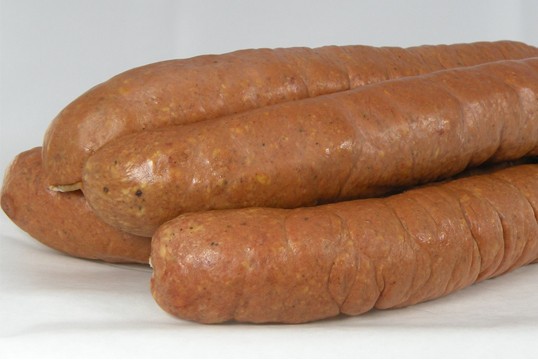
k
Fresh Country Sausage
Fresh country sausage is also commonly known as breakfast sausage because people often serve it with breakfast. This meat is a popular type of American sausage made from pork and mild seasonings. In rural America, farmers came up with tasty ways to use every part of a pig that had been killed. This is where country sausage got its start.
It can come in a few different forms, all of which are raw and require cooking. You can get fresh country sausage as loose sausage meat, in individual links or in longer coils.

Summer sausage is another type of American sausage. Americans use the term “summer sausage” to describe a lot of different kinds of meat, but most of them are a mix of pork and beef. What all summer sausages have in common is that they are cured, which means they don’t need to be chilled before being stored. You can also enjoy them without cooking them.
You can cure summer sausages in different ways, including smoking and drying. Despite the name, this meat tends to be a favorite winter snack.
Another variety of cured sausage that is popular in the U. S is salami, which, like summer sausage, is a general category of sausage. In this case, it refers to fermented, aged sausage. One of the most popular types of salami in the U. S. is Genoa salami, named after the region in Italy where it originated.
This type of salami consists of pork, wine and seasonings. It contains a fair amount of fat, making it soft compared to hard salami. Salami can add a delicious, tangy flavor to cold cut sandwiches.
There is a type of sausage called pepperoni. Most people think of it as Italian, but it is actually American. People make pepperoni from beef, pork or a combination of both. Pepperoni that Americans love to put on pizza is usually either half-cooked or dry, and sausage makers cut it into thin slices. More traditional varieties of pepperoni are dry.
The pepperoni that isn’t meant for pizza is usually bigger, and it can be used to make a deli sandwich taste better, just like other types of salami.
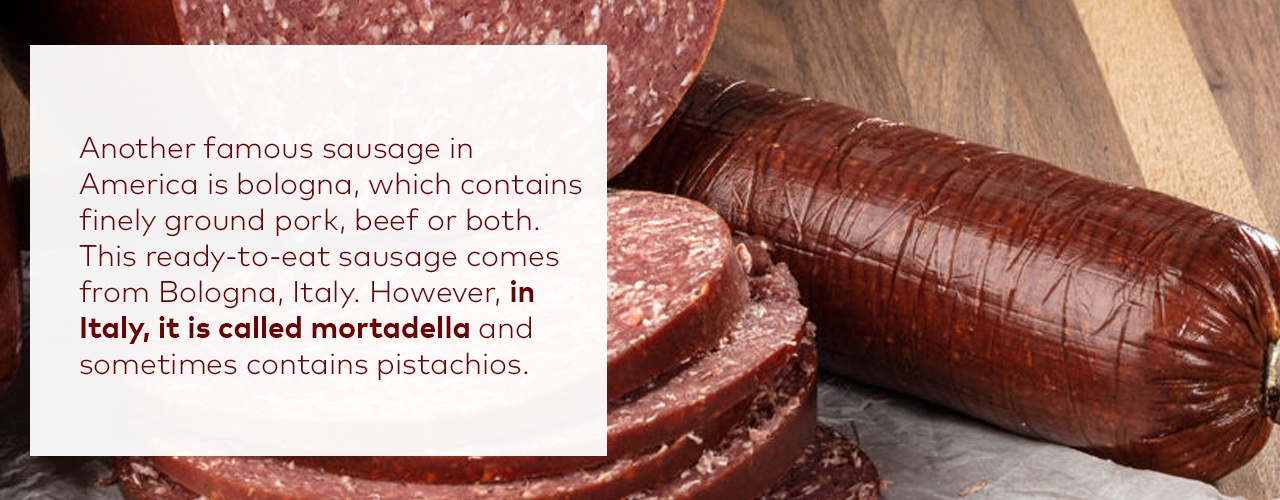
Another famous sausage in America is bologna, which contains finely ground pork, beef or both. This ready-to-eat sausage comes from Bologna, Italy. However, in Italy, it is called mortadella and sometimes contains pistachios. In the U. S. Most people think of bologna as a cheap, mass-produced lunch meat, but it can also be a gourmet, high-quality type of sausage.
An example is Lebanon bologna, a semi-dry fermented sausage made from beef and a unique combination of spices. You can enjoy several other types of gourmet bologna as a snack or on a sandwich.
Technically, any sausage that goes into a smoker as part of its preparation is smoked sausage. But in American grocery stores and delis, you might see some meat ropes that are just marked “smoked sausage.” ” This mildly seasoned sausage is usually fully cooked before being smoked. Traditional types of smoked sausage are still smoked over hardwood fires, even though some mass-produced ones may use fake smoke to add flavor. Slices of smoked sausage are a popular addition to breakfast dishes, potato dishes and bean soups.
Also called wieners or hot dogs, frankfurters are one of America’s favorite sausages. Most of the time, these sausage links are made with a mix of pork and beef, but you can also find ones that are only pork or beef. Frankfurters originally hail from Frankfurt am Main, Germany, but they made their way to the U. S. at the dawn of the 20th century and were an instant hit.
The first hot dog stand, which introduced Americans to frankfurters served in a long bun, opened in 1916 at Coney Island. Frankfurters continue to be a popular summertime food.
Black sausage is any ground meat containing animal blood as part of the recipe. Black pudding, a blood sausage from the UK and Ireland that is often served with breakfast, is one of the most well-known examples. Black pudding consists of pig blood, fat and oats or groats.
This meat is usually cooked before it is sold by sausage makers. It is very dark, which is how it got its name. This recipe may not sound appealing to most Americans, but it is hugely popular across the pond.
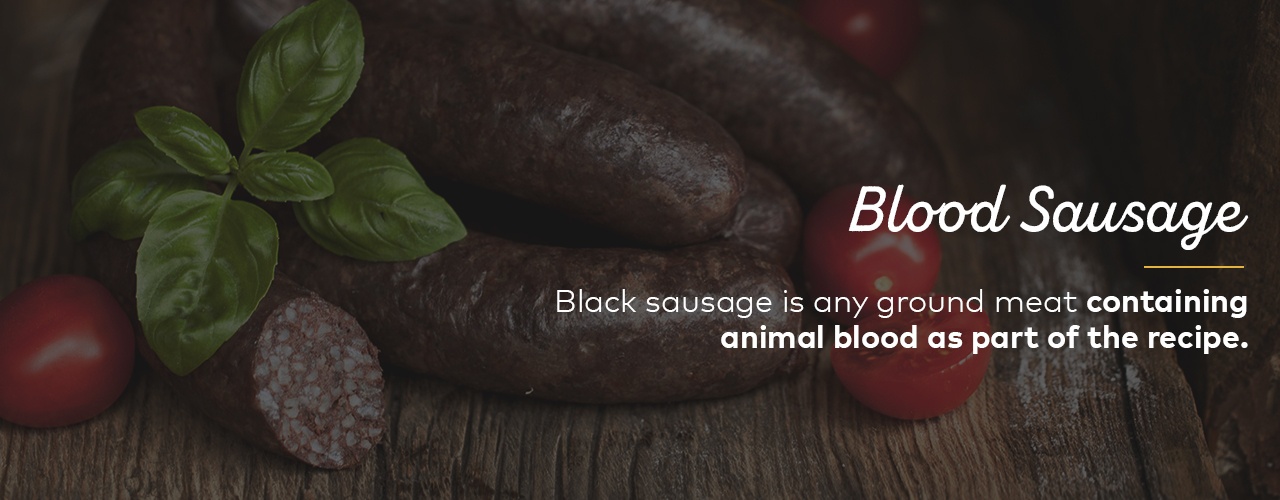
Andouille is French in origin and is a prized ingredient in Cajun cooking. This sausage contains coarsely ground pork along with wine, garlic, pepper and other seasonings. The ground meat is stuffed into a casing and double smoked. This cooking technique makes andouille a flavorful sausage perfect for dishes like jambalaya and gumbo. It comes in ropes or links, and before being added to meals, it is usually sliced and sautéed.
Chorizo is a popular type of spicy pork sausage used in Spanish and Mexican cooking. The Spanish variety is typically smoked and seasoned with garlic and smoked paprika. Mexican chorizo, on the other hand, is raw and seasoned primarily with chile peppers and vinegar. Spanish and Mexican chorizo are not interchangeable, but both are deliciously flavorful and work well in Latin dishes.
One of the most popular chorizo dishes is chorizo and eggs. In the U. S. , you usually find this meat in a ready-to-eat form, either dry or semi-dry.
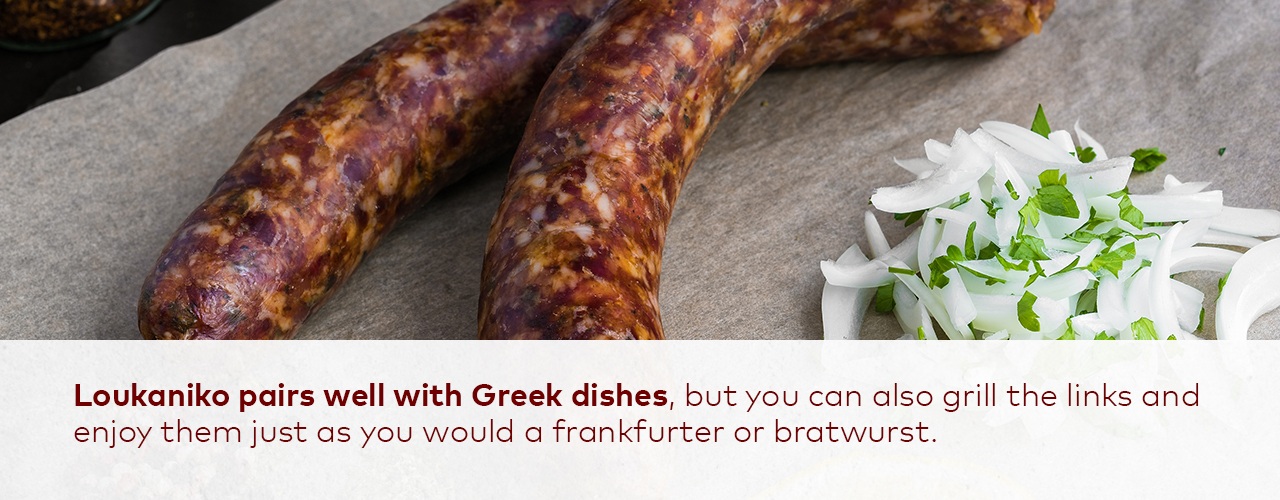
Loukaniko is the Greek word for sausage. The Greeks’ signature sausage includes pork and lamb. It gets its signature flavor from orange zest, along with seasonings like garlic and cumin. Because loukaniko can be made in different ways, it may be sold fresh, semi-dry, cured, or smoked.
Depending on how you prepare this ground meat, it may resemble salami or raw link sausage. Loukaniko goes well with Greek food, but you can also grill the links and eat them like a frankfurter or bratwurst.
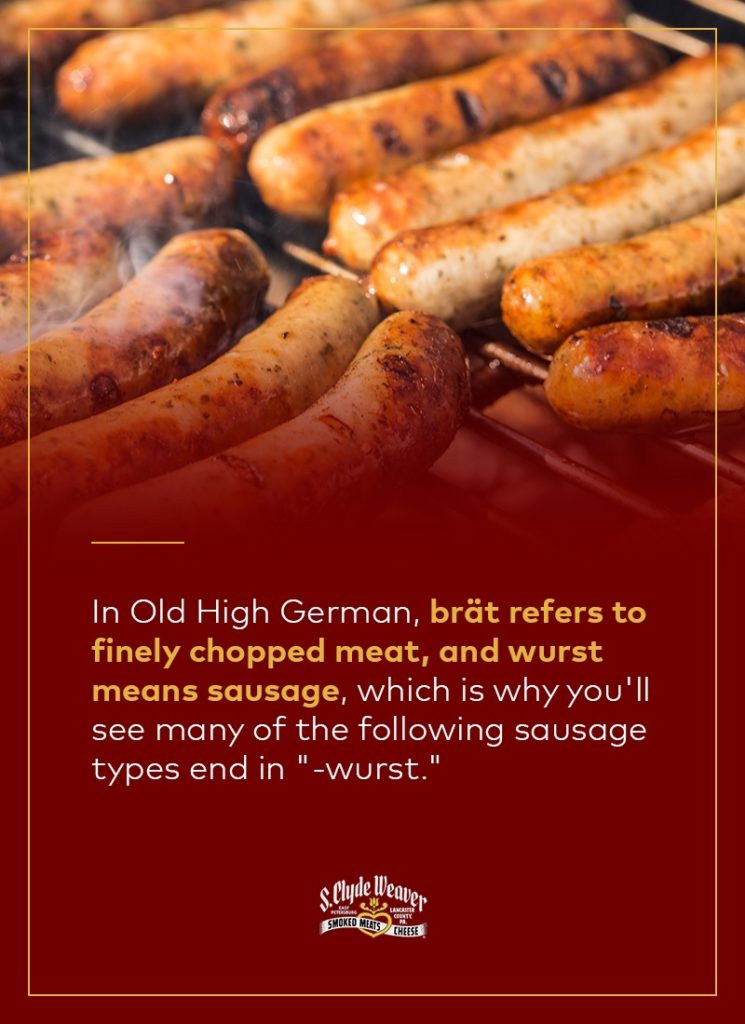
Italy is home to various sausage types, so the term Italian sausage, or salsicca, is relatively broad. Italian sausage is usually sold fresh, either as loose meat or in casings. It traditionally consists of pork and seasonings like fennel, garlic, anise seeds and other spices. In the U. S. Italian sausage comes in both mild and spicy varieties. Mild sausage tastes sweeter, while spicy sausage has red pepper flakes added for heat and flavor. You can grill Italian sausage in individual links and serve them on a bun.
The word “bratwurst” refers to any kind of German sausage that has spices like nutmeg, mace, rosemary, coriander, and black and white pepper. In Old High German, wurst means sausage and brät means finely chopped meat. This is why many of the following types of sausage end in “-wurst.” ” Most often, bratwurst contains pork and sells in links. Americans commonly refer to the individual links as brats, and they grill and serve them like frankfurters. Bratwurst is also great with sauerkraut or potatoes.
Beerwurst — also spelled bierwurst — is a type of Bavarian sausage used as sandwich meat. It is not very common in the U. S. Beerwurst doesn’t contain any beer, but people often pair it with beer as a snack. The unique flavor of this deli-style sausage comes from the pork, beef, and garlic that is used in large amounts. Beerwurst is cooked and smoked, so it is ready to eat. Deli chefs slice it from a large cylinder rather than put it into individual links.
Bockwurst is another popular type of German sausage. Bockwurst is especially prevalent in southeastern Pennsylvania, where German culinary traditions influence the local cuisine. Bockwurst is typically sold raw in links. This sausage is made with pork, veal, mild spices, and fragrant herbs. It’s a type of meat that works well in many dishes. Some examples include boiled cabbage and potatoes or breakfast skillet dishes. Bockwurst is also delicious on its own with a condiment like catsup.
Bauerwurst is also called bauernwurst, or “farmer’s sausage” in German. It is a beef and pork sausage with a rough texture that is full of different spices, like garlic, marjoram, mustard seed, and onion. It is smoked, which contributes to its flavor. Bauerwurst sells in thick links or ropes. It’s safe to eat because it’s been cured, but most people heat it first, like they would with American-style smoked sausage, before putting it in traditional German dishes.
Next in the German section of this list is knockwurst, also spelled knackwurst, which comes from north Germany. It usually contains beef or veal, pork or a combination of these meats. Garlic is the dominant flavor. Knockwurst is traditionally stuffed into natural casings, making them short, plump sausages. The name comes from the German word “knack,” which means “snap.” When you bite into one of these meats, you’ll hear a sound that sounds like this: Knockwurst is best served grilled and goes very well with sauerkraut.
Weisswurst is also called white sausage for its pale, grayish-white appearance. This traditional Bavarian meat may look strange, but it is delicious. It includes pork and veal along with bright-tasting additions like lemon, ginger, parsley and more. Cooks traditionally stuff the sausage into thick natural pork casings. This mild meat is a popular snack in Germany in the middle of the morning, and it’s often served at Oktoberfest with bread, sweet Bavarian mustard, and beer.
Thuringer sausage comes from Thuringia, a state in east-central Germany. The most famous Thuringian meat is known as thüringer rostbratwurst. It consists of pork mixed with some beef or veal and flavorings like garlic, marjoram, caraway and cumin. The oldest recipe for it dates back to the 15th century. The mixture goes into long, narrow casings and may be smoked or sold fresh. Thuringer is generally best prepared through grilling.
Landjaeger, also written as landjäger, is a type of mostly dry, fermented German sausage that people in Pennsylvania Dutch country love to snack on. It’s also called “hunter’s sausage” because hunters, hikers, and other people who spend time outside can eat it right away and it doesn’t need to be chilled. For this reason, it has historically been a useful source of food for soldiers. Landjaeger sausages come as small baton shapes, making them ideal as individual portions.
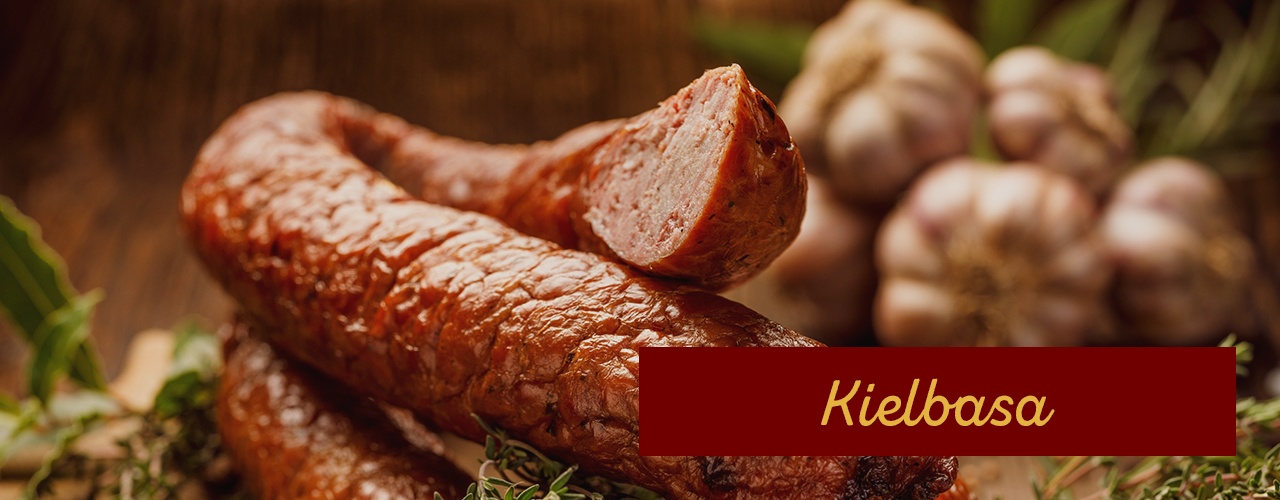
Kielbasa is the Polish word for sausage, so any type of Polish sausage is a kielbasa. The signature kielbasa we know and love in the U. S. , which people refer to as Polish sausage, is a ready-to-eat sausage that comes in a signature U-shape. It consists of coarsely ground pork, garlic and other seasonings. Americans often smoke their Polish-style sausage, which adds to the flavor. When sliced and sautéed, kielbasa goes well with many of the same foods that smoked sausage does, like rice, beans, potatoes, pasta, soups, and more.
As with the broad term “Polish sausage,” Hungarian sausage refers to any sausage from Hungary. This meat contains pork, garlic and paprika primarily. It can also include seasonings like black and white pepper, marjoram, caraway and more. Some varieties even contain white wine or cognac. Hungarian sausage is known for its elongated shape. People sell it fresh, smoked or dried. If you ever get to try Hungarian sausage, try making stew.
Head cheese has the strangest name of any meat, but it makes more sense once you know where this kind of sausage comes from. The coarsely cut meat comes from the heads of livestock, usually calves or pigs. People call it “cheese” because it forms a jelly or loaf-like product. The mix is put into a mold by chefs, and it is cooked. After it is done, it can be sliced and eaten. Head cheese comes from Europe and is not as popular here in the U. S.
Most sausages in the world come from Europe, but ground pork is often used to make sausages in Asian cooking as well. Chinese sausage is any sausage that comes from China. Usually, it’s a dry pork sausage that has been sweetened, salted, and smoked. It may contain ingredients like soy sauce, rice wine and rose water. The flavor of Chinese sausage is great on its own, but it also adds a lot to stir-fry and other Chinese dishes.
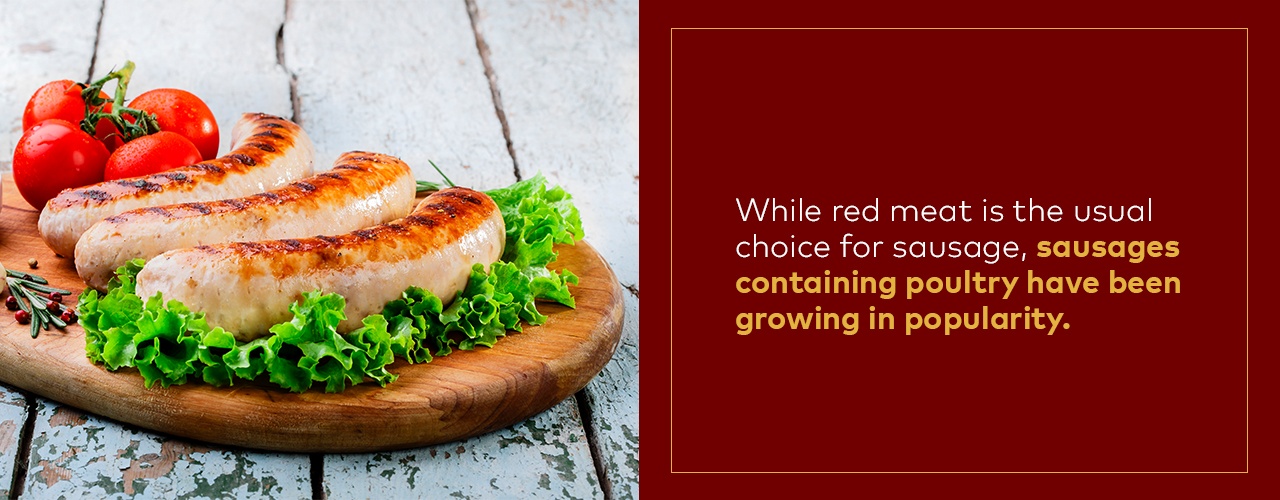
While red meat is the usual choice for sausage, sausages containing poultry have been growing in popularity. Companies often market these products as leaner alternatives to traditional forms of sausage. On the light menu of a breakfast restaurant, for instance, turkey patties or links might be used instead of regular American breakfast sausage. These sausages can be delicious in their own right, though. For example, maple apple sausage grillers make for a mouth-watering breakfast treat.
How Is Sausage Made?
Just like we said, there are different kinds of sausage, so the recipe for making it depends on the type. The essential steps for how people create most sausage types are as follows:
- Step 1: The person making the sausage first minces or grinds the meat and mixes it until it’s the right consistency. Most people choose pork, but beef or veal is often mixed with it before cooking.
- Step 2: Add the spices, and let the sausage mix sit overnight or for long enough for the flavors to blend. Now, any fresh sausage made from loose, ground meat would be ready to sell. But for sausage that is wrapped, there is still one more step to do.
- Step 3: The mix is put into a machine that pours it out of a spout. The natural or man-made casings are stacked on top of the spout. As the sausage comes through, it fills the casing.
- Step 4: When the casing is full, it can stay in a rope shape, or the sausage maker can pinch it at regular intervals and spin the sausage to make closed-off areas. Then, the person making it can cut these seams to make separate links.
- Step 5: The next step for some sausages is to cook, smoke, or do both. Smoking sausage can make it taste better, keep it fresh, and make it ready to eat. Another way to change the taste and keep the meat fresh is to hang some sausages to dry-age.
There are multiple styles or levels of preparation you’ll find among different types of sausages. It’s helpful to understand the difference between these classifications:
- Fresh sausage: Fresh sausage is raw. It can be bought in stores in ropes, links, or a loose ground mix. You must cook this type before consuming it. It’s best to boil link sausage and then sear or grill the outside to make it brown.
- Cooked sausage: This sausage is made from fresh, cooked meat, so it’s ready to eat as soon as you buy it. A typical example is hot dogs. These meats will stay fresh until you eat them if you put them in the fridge.
- Smoked sausage: Sausage is either slowly smoked or cooked and then smoked. This sausage is ready to eat, but most types need to be kept cold.
- Semi-dry sausage: These types of sausage are partly dried, as the name suggests. This is done while the sausages are being smoked, which also cooks them all the way through. Semi-dry sausages are often shelf-stable.
- Full-dry sausage has been aged and cured, so it is ready to eat and doesn’t need to be kept cold. Most people eat them as a snack or as part of a meal. You can eat them as a stick or cut up from a whole sausage.
12 Typical German Sausages Compared – Traditional German Sausages
FAQ
What are those long sausages called?
What is a large Italian sausage called?
What is the longest type of sausage?
What is a big foot sausage?
Why is sausage called a sausage?
The name is derived from the Latin word “salus,” meaning “salted,” which was the standard preservation method used for the meat. The sausage was particularly valuable for these early societies because it was a way to use up the less desirable parts of the animal, like the intestines for the casings and the organ means for the fillings.
Is sausage casing healthier option to eat?
Cellulose casings and some natural casings are perfectly fine to eat. Sausage casings are used to hold and shape filling inside so that it can be cooked. There are natural sausage casings and synthetic varieties, and most of them are edible. The healthiest way to cook them is by boiling or baking. Sausages provide high levels of vitamin B12 and iron, both of which are essential for healthy red blood cells and hemoglobin production.
What is a cooked sausage?
Image Source/Getty Images Cured sausages are what Italians call salumi and the French call charcuterie. They are sausages made fresh and then salted and air-dried for weeks or months depending on the type. The meat gets “cooked” by the salt and air (and, in a way, time).
What is a fresh sausage?
Fresh sausage is made from raw meat (most often pork) and is typically cooked before eating. These sausages can be made with a wide range of meats like: They are then seasoned with various spices and herbs, such as parsley, Italian seasoning, black pepper, fennel seed, paprika, red pepper flakes, salt, and onion powder.
